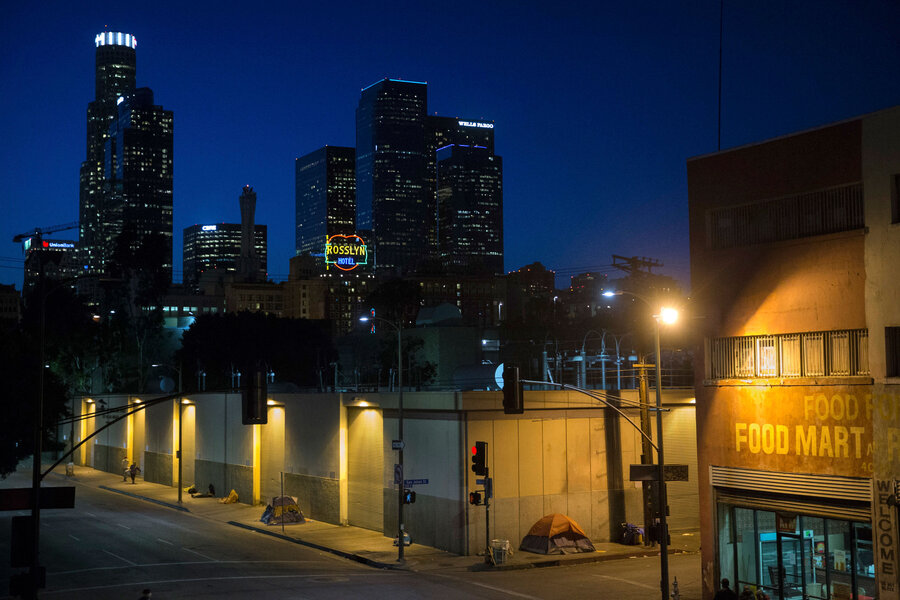Homeless and transgender: HUD set to issue new shelter regulations
Loading...
“We don’t allow that type of thing here.”
Anton Darknight, a homeless transgender man, finally got a straight answer as to why he had to bounce from homeless shelter to homeless shelter, repeatedly turned away for a variety of vague reasons. Mr. Darknight says the staff started treating him differently when he began growing a beard, months into hormone therapy. The discomfort his process of transitioning to male elicited in others made his already perilous living situation even more unstable, Darknight told the Boston-based street paper Spare Change News in 2012.
Four years later, the US government is taking steps to ensure that transgender individuals in desperate situations like Darknight's can find a place in the nation's emergency shelter system.
The Department of Housing and Urban Development (HUD) is scheduled to finalize in September new regulations that would require shelters to accommodate transgender individuals based on the gender with which they identify. The rule, which would apply to all shelters that receive federal funds, comes at a time when many public institutions are struggling to balance accommodations for transgender individuals with privacy and safety concerns, as exemplified in heated debates that have taken place in several states over access to gender-specific bathrooms.
“A person seeking shelter is already in a very vulnerable situation, and they deserve to be treated with dignity when they request our assistance,” HUD Secretary Julián Castro said in a statement when the rule was first proposed in November. “This rule takes us one step closer to full acceptance of transgender men and women, and will ensure they receive the proper services that respect their identity.”
According to a 2011 National Transgender Discrimination Survey, nearly one in three trans people who sought access to homeless shelters had been turned away on the basis of gender identity at some point in their lives. Of those accepted to the shelter, 42 percent were forced to stay in facilities designated for the gender they were born with, rather than that with which they identified. Many respondents reported experiencing harassment, and physical and sexual abuse and nearly half said they had to leave the shelter because of this abuse.
A study conducted in 2015 revealed similar experiences. Researchers called up 100 homeless shelters to inquire if they had space available for a transgender woman. Only 30 percent of shelters were willing to house transgender women with other women, according to the Center for American Progress and Equal Rights Center test conducted in four states. Another 21 percent refused them shelter altogether.
But the legal context appeared to make a difference: Connecticut and Washington, which have gender identity non-discrimination protections, were twice as willing to accommodate transgender women based on the way they identify as compared to Tennessee and Virginia, which lack the legal protections.
Currently, while HUD forbids discrimination against LGBT individuals in housing that receives federal funding, the protection is not extended to shelter-seekers. The new regulation seeks to address this loophole – some say at the expense of the wellbeing of other homeless shelter residents.
Tim Wildmon, president of the American Family Association, told The Hill. “No one is in favor of beating up transgender people, but why do you have to force other people to feel really uncomfortable, and in some cases unsafe, just to make your political point?” Wildmon lamented that the proposal would "make room for people who are sexually confused at the expense of everyone else."
It's more than a matter of feeling uncomfortable, say some opponents of the new federal rules. “I am not saying that transgender people are predators," says a former rape victim, quoted in an opinion piece in the University of Texas's University Star in a piece on transgender bathrooms. "Not by a long shot. What I am saying is that there are countless deviant men in this world who will pretend to be transgender as a means of gaining access to the people they want to exploit, namely women and children. It already happens."
She goes on to mention press accounts of three situations in different states where men dressed as women to gain access to bathrooms or dressing rooms for illicit purposes.
When it comes to shelters, some providers say the new rules limit their ability to protect their clients. "While we support the effort to ensure that all persons have access to shelter, we remain concerned that the proposed rule exceeds the current statutory mandate," Brian R. Corbin, executive vice president of member services & social policy at Catholic Charities USA, wrote in a public comment to HUD's proposed rule. "In addition, its standard for placing individuals in shelters based on their self-identification exceeds the practices of other Federal programs and fails to provide local service providers with the flexibility needed to maintain order and protect the privacy, health and security concerns of a diverse population."
Other shelter providers, however, don't necessarily see a conflict between admitting transgender guests and maintaining security. At the Preble Street's Florence House homeless shelter in Portland, Maine, for instance, Mark Swann, executive director of Preble Street, told The Portland Press Herald, “We don’t discriminate against anybody. We accept people at the shelter as they present themselves.” However, Mr. Swann also noted that if there is any "inappropriate behavior," that person would be removed, regardless of gender.
While the number of homeless transgender individuals is small in comparison to the greater shelter population, rates of homelessness among transgender individuals is quite high. The National Health Care for the Homeless Council estimates that 1 in 5 transgender individuals are at risk of becoming homeless.
The dangers transgender people face are often misunderstood and hidden from public view, says Laura Durso, senior director of LGBT research at the Center for American Progress.
"Only about one in ten Americans say they know a transgender person. A lot of the stories that transgender people have are absent from general discussion. Some of the pushback we see is, is this really a problem? Who are transgender people and what do they need?" Dr. Durso tells The Christian Science Monitor.
"Even things that seem subtle and for the purpose of protecting someone, like being given a separate facility in the shelter, being isolated is a form of discrimination," Durso says.
Under the new regulation, transgender women would be accommodated with other women in shared sleeping and bathing spaces and same for transgender men with other men, according to the proposed regulation.
HUD's proposed regulation instructs shelters to disregard complaints of other shelter residents when the sole basis for the complaint is the perceived gender.
"A recipient may not make a determination about services for one beneficiary based on the complaints of another beneficiary when those complaints are based on gender identity," the proposal states. The provision does allow that "under narrow circumstances, a written case-by-case determination can be made as to whether an alternative accommodation is necessary to ensure health and safety."
Accommodations for transgender individuals in public institutions has become a point of tension in the United States as celebrities such as Chaz Bono and Caitlyn Jenner have brought a spotlight to a largely unrecognized population. Legal battles over which bathroom transgender students should be permitted to use in school and other public places have sparked a heated national debate.
In May, the Obama administration directed public schools to provide transgender students with facilities, including bathrooms and locker rooms, appropriate to their gender identity. Billions of dollars of federal funding is at stake for schools. Americans aged 18 to 29 favor letting transgender people use the restroom of their identity by a 2-to-1 ratio. The Justice Department is challenging North Carolina's law, which requires people to use public restrooms in accordance with their assigned gender at birth.
"It's a tough time right now for the rights of transgender people. On the one hand we're seeing incredibly increased visibility of transgender people. We just had the first transgender people address a political party convention," says Durso. "On the flip side, we've seen increased legislative attacks on the rights of transgender people, especially with the North Carolina bill. I take heart that the Obama administration has told transgender people that they have their back and are still pushing forward with the appropriate legislation."
“Ultimately, the issue is won or lost on the public level, not on the legal level, where we have to become familiar with what it means to be transgender,” Katherine Franke, the director of the Center for Gender & Sexuality Law at Columbia Law School in New York told the Monitor in June. It’s clear that “there’s a tremendous anxiety around gender identity and what it means to be a man or a woman – which, in turn, are pretty fundamental questions.”






